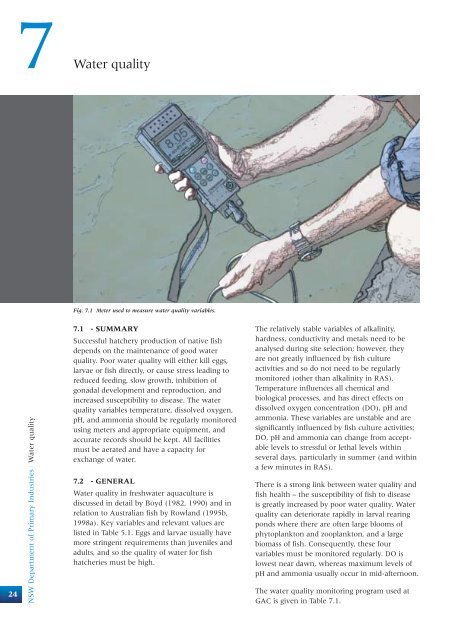Hatchery Quality Assurance Program - NSW Department of Primary ...
Hatchery Quality Assurance Program - NSW Department of Primary ...
Hatchery Quality Assurance Program - NSW Department of Primary ...
You also want an ePaper? Increase the reach of your titles
YUMPU automatically turns print PDFs into web optimized ePapers that Google loves.
7 Water<br />
quality<br />
Fig. 7.1 Meter used to measure water quality variables.<br />
24<br />
<strong>NSW</strong> <strong>Department</strong> <strong>of</strong> <strong>Primary</strong> Industries | Water quality<br />
7.1 - SUMMARY<br />
Successful hatchery production <strong>of</strong> native fish<br />
depends on the maintenance <strong>of</strong> good water<br />
quality. Poor water quality will either kill eggs,<br />
larvae or fish directly, or cause stress leading to<br />
reduced feeding, slow growth, inhibition <strong>of</strong><br />
gonadal development and reproduction, and<br />
increased susceptibility to disease. The water<br />
quality variables temperature, dissolved oxygen,<br />
pH, and ammonia should be regularly monitored<br />
using meters and appropriate equipment, and<br />
accurate records should be kept. All facilities<br />
must be aerated and have a capacity for<br />
exchange <strong>of</strong> water.<br />
7.2 - GENERAL<br />
Water quality in freshwater aquaculture is<br />
discussed in detail by Boyd (1982, 1990) and in<br />
relation to Australian fish by Rowland (1995b,<br />
1998a). Key variables and relevant values are<br />
listed in Table 5.1. Eggs and larvae usually have<br />
more stringent requirements than juveniles and<br />
adults, and so the quality <strong>of</strong> water for fish<br />
hatcheries must be high.<br />
The relatively stable variables <strong>of</strong> alkalinity,<br />
hardness, conductivity and metals need to be<br />
analysed during site selection; however, they<br />
are not greatly influenced by fish culture<br />
activities and so do not need to be regularly<br />
monitored (other than alkalinity in RAS).<br />
Temperature influences all chemical and<br />
biological processes, and has direct effects on<br />
dissolved oxygen concentration (DO), pH and<br />
ammonia. These variables are unstable and are<br />
significantly influenced by fish culture activities;<br />
DO, pH and ammonia can change from acceptable<br />
levels to stressful or lethal levels within<br />
several days, particularly in summer (and within<br />
a few minutes in RAS).<br />
There is a strong link between water quality and<br />
fish health – the susceptibility <strong>of</strong> fish to disease<br />
is greatly increased by poor water quality. Water<br />
quality can deteriorate rapidly in larval rearing<br />
ponds where there are <strong>of</strong>ten large blooms <strong>of</strong><br />
phytoplankton and zooplankton, and a large<br />
biomass <strong>of</strong> fish. Consequently, these four<br />
variables must be monitored regularly. DO is<br />
lowest near dawn, whereas maximum levels <strong>of</strong><br />
pH and ammonia usually occur in mid-afternoon.<br />
The water quality monitoring program used at<br />
GAC is given in Table 7.1.

















